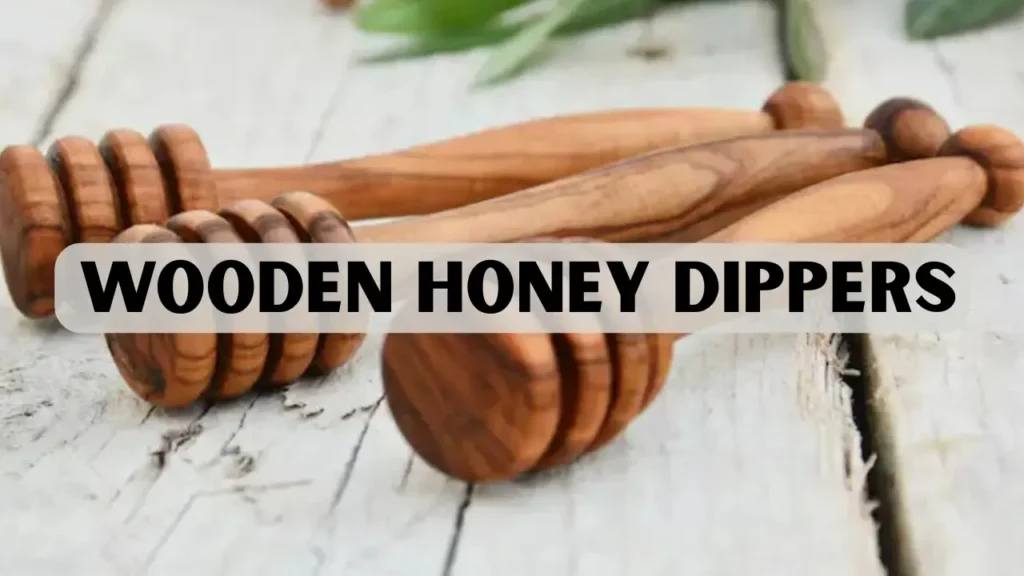Honey dippers have been essential kitchen tools for centuries, providing an easy and efficient way to drizzle honey without creating a sticky mess. Crafting your own wooden honey dippers allows you to combine functionality with artistry, resulting in a utensil that is both practical and visually appealing. Using high-quality hardwoods like maple, cherry, or walnut ensures durability and food safety. This project also gives woodworking enthusiasts valuable hands-on experience, helping them refine lathe skills while creating something unique and functional.
Handcrafted honey dippers offer more than just functionality, highlighting precision and skilled craftsmanship that mass-produced items often lack. Each dipper can be personalized in handle shape, groove design, and finish to reflect individual style or kitchen décor. Using proper woodworking techniques ensures durability, safety, and structural integrity. Creating dippers with care demonstrates expertise and reliability, resulting in a high-quality tool that can be enjoyed for years.
Why Wooden Honey Dippers Are an Excellent Choice
Wooden honey dippers have long been preferred over plastic or metal utensils for several important reasons. The natural composition of wood makes it safe for food contact, unlike plastic, which can release chemicals, or metal, which may react with certain liquids. Hardwoods such as maple, cherry, and walnut are durable, allowing the dippers to last for years with proper care.
Beyond safety and longevity, these dippers offer exceptional customization. Crafters can adjust the handle length, groove shapes, and head size to match personal preferences, making each piece unique. The natural texture and warmth of wood also add a charming aesthetic that enhances honey presentation, and handmade dippers make thoughtful gifts that blend practicality with artistry.
Creating these utensils is more than a simple woodworking project; it is an opportunity to engage creatively while honing precision and skill. Unlike mass-produced alternatives, handcrafted dippers tell a personal story, reflecting the care and craftsmanship invested in every piece..
Materials Required
Before starting your project, it is important to gather all the necessary materials and tools to ensure a smooth and safe woodworking experience. Choosing the right wood is crucial because it affects both the durability and appearance of the final honey dipper. Maple is an excellent option thanks to its smooth texture, light color, and resilience. Cherry wood offers a warm, reddish tone that deepens with age, creating an inviting look.
Walnut is another popular choice, known for its dark, elegant appearance and strength, making it ideal for a sophisticated finish. Soft or porous woods should be avoided, as they can absorb honey and may become damaged more easily over time. Selecting hardwoods carefully ensures that your handcrafted dipper remains durable and functional for years to come.
In addition to wood, several tools are required for successful creation. A wood lathe provides the rotation needed for shaping, while turning chisels, such as spindle gouges and parting tools, help carve the handle and grooves precisely. Sandpaper, ranging from coarse to fine (120–400 grit), smooths the surface, and a food-safe finish like mineral oil or beeswax protects the dipper. Optional tools like calipers can help measure groove depth and handle thickness, ensuring a professional-quality result.
Step by Step Process
The process of crafting wooden honey dippers is methodical and requires patience. By following each step carefully, you can achieve a polished, functional, and attractive result.
Step 1: Preparing the Wood Blank
The first step involves selecting a suitable hardwood blank and cutting it to a length of approximately six to eight inches. Inspect the blank for any knots, cracks, or imperfections that could affect the structural integrity of the dipper. Smoothing the surface of the blank makes it easier to mount on the lathe and ensures even shaping throughout the project. Careful preparation of the wood blank sets the foundation for a successful project and reduces the likelihood of errors later.
Step 2: Mounting the Blank on the Lathe
Next, secure the blank on the wood lathe using either a spur center or a faceplate, depending on the blank’s shape and size. Proper alignment is critical to ensure that the blank rotates evenly, which allows for precise shaping of the handle and head. Taking the time to check alignment and stability before turning the lathe reduces the risk of mistakes and enhances safety during the project.
Step 3: Shaping the Handle
Shaping the handle involves using a spindle gouge to taper the wood to a comfortable thickness. The handle should be smooth and ergonomic to provide a secure and comfortable grip during use. Gradually sanding the handle while it rotates on the lathe helps eliminate rough spots and ensures a consistent texture. A well-shaped handle not only improves usability but also contributes to the overall aesthetic of the dipper.
Step 4: Shaping the Head
The head is the functional part of the honey dipper where the honey collects. Begin by rounding the end of the blank and gradually forming a bulbous shape. Uniformity is essential, as uneven shaping can interfere with honey flow. Using calipers or careful visual assessment ensures that the head is symmetrical and consistent, resulting in a dipper that performs as well as it looks.
Step 5: Carving the Grooves
Grooves are essential for collecting and drizzling honey. Using a small gouge or parting tool, carve evenly spaced grooves around the head. The grooves should be deep enough to hold honey without compromising the wood’s strength. Taking time to make consistent grooves improves both functionality and appearance, allowing honey to cling effectively and flow smoothly when drizzled.
Step 6: Sanding and Smoothing
Sanding the dipper progressively from coarse to fine grit ensures a polished, smooth surface. Pay particular attention to the grooves, as honey can stick to rough edges. Smooth grooves and rounded edges make the dipper functional and visually appealing. Proper sanding enhances both usability and longevity.
Step 7: Applying a Food-Safe Finish
The final step is applying a food-safe finish to protect the wood and make it safe for honey contact. Mineral oil or beeswax are excellent choices. Apply several coats, allowing each layer to absorb fully before adding the next. The finish not only preserves the wood but also enhances the natural color and grain, creating a finished product that is both durable and attractive.
Tips for Crafting High-Quality Honey Dippers
Achieving professional results requires careful attention to detail and precise technique. Choosing straight-grain hardwood helps prevent splitting during carving and ensures even, well-defined grooves. Maintaining consistent groove spacing improves honey flow and enhances the overall appearance of the dipper. Rounding the handle edges increases comfort, making the utensil easier to hold during use.
Safety is equally important throughout the crafting process. Always wear eye protection and follow standard lathe safety guidelines to avoid accidents. By adhering to these tips, woodworkers can create dippers that are both functional and visually appealing while ensuring durability and reliable performance.
Creative Variations and Design Ideas
After mastering basic techniques, you can experiment with creative designs for wood honey dippers. Twisted handles add visual interest and improve grip, while combining contrasting woods produces a striking appearance. Engraving or carving patterns and initials personalizes the dipper, making it an ideal gift. Miniature versions are perfect for tea or single-serve honey jars. Exploring these variations allows woodworkers to express creativity and develop advanced skills, resulting in unique and attractive finished products.
Maintenance and Care
Proper care ensures the longevity of handcrafted honey dippers. Clean the dipper by rinsing it with warm water only, avoiding soaking or using a dishwasher, which can damage the wood. Dry it immediately and allow it to air dry completely. Periodically reapplying mineral oil or beeswax helps maintain the wood’s integrity and appearance. Storing the dippers away from direct sunlight prevents warping or cracking. By following these care practices, you can enjoy their functionality and beauty for many years.
Common Mistakes to Avoid
Common mistakes include using soft or porous wood, carving uneven or overly deep grooves, skipping sanding or finishing steps, and ignoring lathe safety procedures. Avoiding these errors enhances both the safety of the project and the quality of the finished product. Attention to detail and careful adherence to each step ensures that the final dipper is durable, functional, and visually appealing. Taking the time to plan and prepare each stage of the process also helps prevent mistakes and achieves professional results.
Real-World Insights and Case Studies
Experienced woodturners recommend starting with smaller practice blanks to refine techniques before attempting larger or more decorative dippers. Even spacing and uniform groove depth are crucial for smooth honey flow. Many hobbyists have successfully made wooden honey dippers as both personal kitchen tools and unique gifts. This project not only produces a functional item but also hones skills applicable to other woodworking projects, such as crafting spatulas, rolling pins, or salad servers.
By studying the methods of seasoned craftsmen and practicing carefully, woodworkers can achieve consistent, professional-quality results. Patience, attention to detail, and repeated practice ensure that each dipper meets high standards of both functionality and craftsmanship.
Conclusion
Crafting wooden honey dippers is a rewarding and satisfying project for woodworkers of all skill levels. From selecting the right hardwood to carving grooves, sanding, and applying a food-safe finish, each step contributes to a functional and attractive kitchen tool. Handcrafted dippers offer both aesthetic charm and practicality, making them ideal for personal use or gifting. With attention to detail, creative variations, and proper care, these utensils will remain durable, visually appealing, and fully functional for years, turning a simple piece of wood into a timeless kitchen accessory.
FAQs
Can any type of wood be used for honey dippers?
Hardwoods such as maple, cherry, and walnut are ideal. Avoid soft or porous woods to prevent staining, splitting, or absorbing honey.
How long does it take to make a wood honey dipper?
For beginners, making a dipper typically takes one to two hours, including sanding and finishing. Experienced woodturners may complete a dipper in under an hour.
Is sanding necessary before finishing?
Yes. Sanding ensures a smooth surface for honey to flow freely and creates a polished, professional look.
What type of finish is safe for food use?
Mineral oil, beeswax, and other food-safe finishes are recommended. Avoid chemical
Can handmade honey dippers be sold?
Yes. Artisanal honey dippers are popular for gifts and products. Ensure they are properly finished for food safety.




